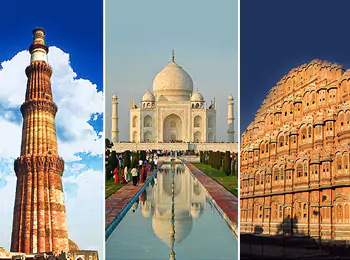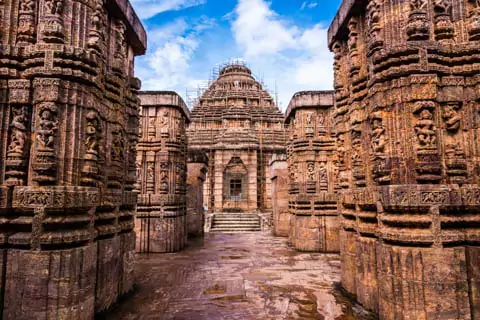India: Traditions And Customs
A four thousand years of continuous and worldwide famous culture has implied that various Indian traditions and conventions have come down to the present age nearly without a change and have gotten profoundly established in the Indian lifestyle.
Indian tradition ranges from the aarti done to welcome the visitors to touching the feet of the elder ones. These traditions perpetually summon interest in the psyches of visiting outsiders enticing them to consider what they mean. Experience the customs that have stayed unaltered throughout the hundreds of years. Get to know the cutting edge. What's more, reclaim a cut of India you won't discover anyplace else!
Beneath we are giving a portion of these traditions which have remained uncut part of Indian traditions for more than thousand years...
Namaskar
Namaskar or Namaste is the most well known type of welcome in India. It is a general greeting that is utilized to welcome or invite someone and furthermore for saying goodbye. While doing Namaskar, both the palms are put together and raised beneath the face to welcome an individual. It is accepted that both the hands symbolize one personality, or oneself gathering oneself. While the correct hand speaks to higher nature, the left hand signifies common or lower nature.
Prostrating before parents and elders
Indians prostrate before their parents, older ones, instructors and respectable spirits by contacting their feet. The senior thus favors by setting their hand on their heads. Contacting the feet in surrender is an indication of regard for the age, development, honorability and eternality that our older folks exemplify. It symbolizes our acknowledgment of their benevolent love for us and the penances that they have accomplished for our welfare. It is a method for submissively recognizing the enormity of another and makes a situation of shared love and regard among individuals guaranteeing concordance in the family and society.
Charan Sparsh
Charan Sparsh is a regularly drilled Hindu custom of bowing down to another person and contacting their feet in respect. The exacting interpretation of Charan Sparsh is 'feet contacting'. Charan signifies 'feet' and sparsh signifies 'contact.'
Charan Sparsh is by and large performed by contacting the feet of one's parents, older ones, teachers, respectable individuals and sadhus with two hands. The senior thus favors one by putting their hand on or over one's head. It is a custom that is performed day by day when we meet older folks, especially on significant events like the start of another undertaking, birthday celebrations, celebrations, New Year's day, and so forth. In certain conventional circles, charan sparsh is joined by abhiv達dana - presenting oneself or reporting one's family and social stature.
Performing charan sparsh of someone else is an indication of regard for the age, development, honorability and additionally godliness of that individual. It symbolizes our acknowledgment of their caring affection for us and the penances that they have made for our welfare. It is a method for submissively recognizing the significance of another. This convention mirrors the solid family ties which have been one of India's suffering qualities.
The sankalp (great wishes) and ashirwad (endowments) of elders are profoundly esteemed in India. We do charan sparsh to take blessings fromthem. Great wishes make positive vibrations. Great wishes springing from a heart of affection, eternality and honorability have huge quality. At the point when we do charan sparsh with quietude and regard, we conjure the great wishes and gifts of older folks which stream as positive vitality to wrap us. This is the reason the stance accepted, regardless of whether it is in the standing or inclined position, empowers the whole body to get the vitality.
This tradition reduces personal arrogance and creates an environment of mutual love and respect among people ensuring harmony in the family and society.
Tilak (Tika)
Tilak is a custom imprint on the temple. It tends to be placed in numerous structures as an indication of gift, welcome or promise. The Tilak is typically made out of a red vermilion powder mixed with water (kumkum) which is a blend of turmeric, alum, iodine, camphor and so on. It can likewise be made of a sandalwood glue (chandan) mixed with musk. The Tilak is applied on the spot between the foreheads which is viewed as the seat of inactive intelligence and mental focus, and is significant for adore. This is the spot on which yogis contemplate to get one with Brahma. It likewise demonstrates where the profound eye opens. All beliefs and activities are said to be administered by this spot. Putting of the shaded imprint symbolizes the mission for the 'opening' of the third eye.
All customs and services of the Hindus starts with a Tilak bested with a couple of grains of rice set on this spot with the pointer or the thumb. A similar custom is followed while inviting or saying goodbye to visitors or relations.
Aarti
Aarti is proceeded as a demonstration of reverence and love. It is regularly carried as a characteristic of love and to look for gifts from God, to invite visitors, for youngsters on their birthday celebrations, relatives on promising events or to respect a recently married couple. The Aartis is likewise performed to avoid abhorrent impacts and the malefic impact of the 'hostile stare'.
For performing Aarti, five little lights called niranjanas are loaded up with ghee or oil and organized in a little plate made of metal. A wick is made out of cotton fleece and set in the lights. A conch-shell loaded up with water, propitious leaves or blossoms, incense or lit camphor are likewise set in the plate. The lights are lit and the plate is turned in a round movement before the divinity or the individual to be invited.
Garlanding
Flower garlands are by and large offered as a characteristic of regard and respect. They are offered to respect the guests or to pay tribute to the Gods and Goddesses. The laurels are commonly made with white jasmine and orange marigold blossoms. They are weaved in string connected the conclusion to the assistance of a bunch.
Bindi
A bindi is a favorable imprint worn by little youngsters and ladies. Bindi is gotten from Bindu, the Sanskrit word for speck. It is normally a red speck made with vermilion powder which is worn by ladies between their eyebrows on their temple.
Thought about an image of Goddess Parvati, a bindi connotes female vitality and is accepted to secure ladies and their spouses. Customarily an image of marriage, it has additionally become brightening and worn today by unmarried young ladies too. Never again confined fit as a fiddle, bindis are seen in numerous brilliant hues and in various shapes and structures.
Explore culture and history of India, Indian conventions, individuals way of life, Rajasthan and North India rich culture visits, neighborhood reasonable and celebrations, summer and winter celebrations, North India visit, Khajuraho visit, North India culture visit, North India visit bundle, Taj Mahal visit, Tamilnadu, South India Kerala occasions, Rajasthan authentic visits, Karnataka culture and customary visits, Karnataka journey visits, recorded spots and the travel industry manage for South India, Tamil Nadu Beach visit, Tamil Nadu Cultural visit, Tamil Nadu sanctuary visit, India Wildlife Travel: Elephant Safari in India, North India untamed life visits bundle, visitor places touring, air terminal exchange, vehicle administrations, hotel appointments, we give the visits to abroad tourists from UK, USA, Australia, Europe, Italy, France, Germany, Canada, Russia, Spain. Joined Kingdom, US, Singapore, distant east nations, particular for inbound visitors from everywhere throughout the world.
To see the exceptional very much planned visit program of most outlandish traveler goals of all over India: if it's not too much trouble visit: https://www.traveltoindia.org/india-visit%20packages. To design out the visit program and cost, if it's not too much trouble educate us: nos. of days for the visit, nos. of individual touring together, favored goals, travel period, classification of the inns a particular necessity.




